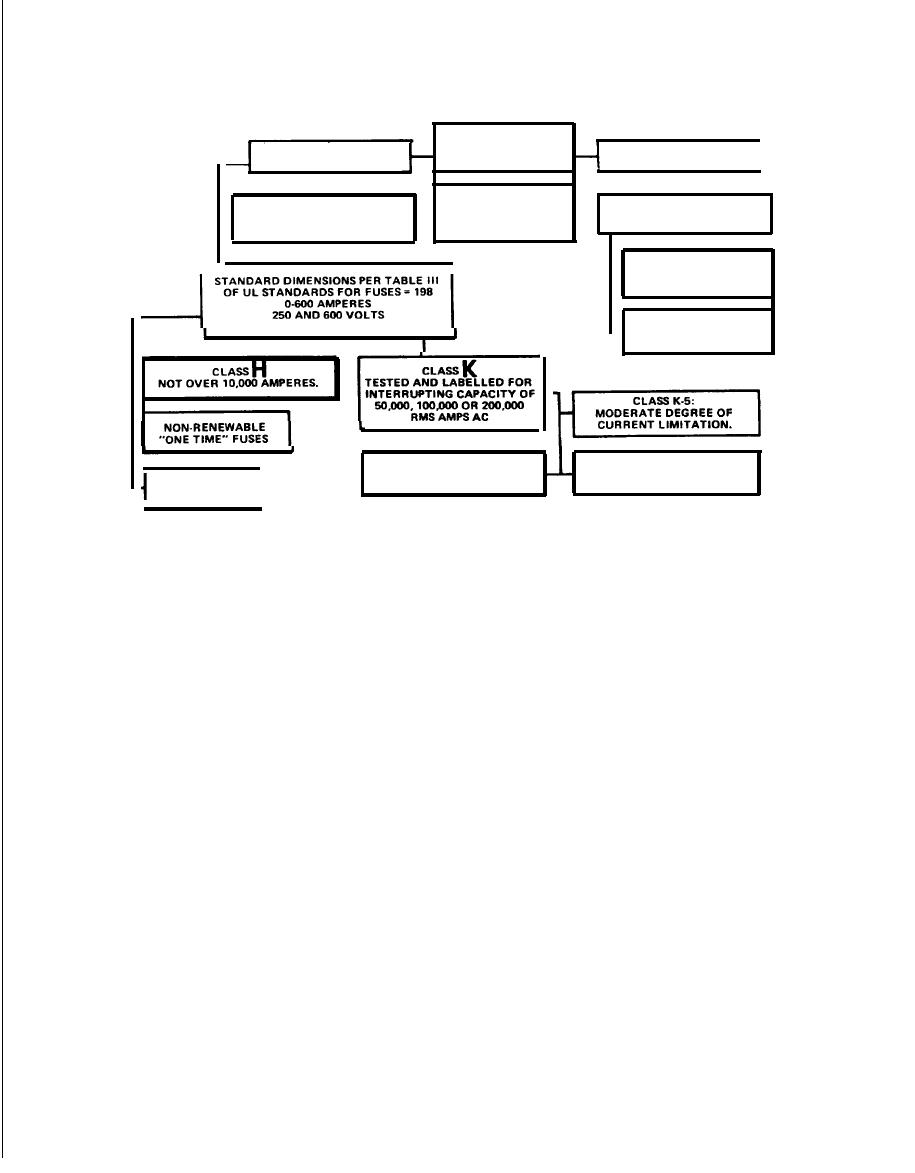

Custom Search
|
|

|
||
 TM 5-683/NAVFAC MO-116/AFJMAN 32-1083
CARTRIDGE FUSES
0-600 v.
NON CURRENT LIMITING
CURRENT LIMITING
1
I
I
I
r
G
TESTED AND UL LISTED
300 VOLTS
"MISCELLANEOUS"
CLASS
"600 VOLTS OR LESS"
SPECIAL DIMENSIONS
MIDGET DIMENSION, ETC.
1
J
r
CLASS
0-600 AMPS.
1
100,000 OR 2OO,OOO/AC
L
CLASS
601-6000 AMPS
100,000 OR 200,00/AC
CLASS K-9:
CLASS K-1 :
FAIR DEGREE OF
HIGH DEGREE OF
RENEWABLE
CURRENT LIMITATION.
CURRENT LIMITATION.
LINK FUSES
I
Figure 5-13. Underwriters' Laboratories cartridge fuse classification.
sized and the line current and ambient temperature
e. Thermal overloads. Thermal overload relays
are normal, then check the relays. The relays
contained in starters provide more precise motor
should be tested and replaced if required. Unfortu-
protection against overloads and momentary surges
nately, the overload relays that serve as safety
than fuses or circuit breakers. However, they do not
valves to protect the motors from burnouts due to
provide short circuit protection. Relays themselves
faults and overloads, sometimes fail to respond
require little maintenance other than occasional
properly. For example, aging and inactivity followed
testing to ensure that they are operational. Thermal
by metal fatigue in some relay types may result in a
overloads should be checked and resized whenever
failure to operate under conditions of overload. Pe-
the motor is replaced to adequately protect the mo-
riodic testing of the relays under load conditions,
tor. The relays are controlled by heater elements (fig
checking the tightness of all overload connections
5-14) which are in series with the motor current.
and inspecting for contact overheating and cleanli-
The size of the heater must match the motor being
ness forms an important part of a good motor con-
protected. Be especially careful if the motor has
trol maintenance program. Suitable test instru-
been oversized to compensate for lower load current
ments are available that provide a dummy load to
with lower rated heaters to cause tripping on loss of
the relay and measure the time interval required to
one phase (single phasing). It often happens that
open the contacts. Their use is highly recom-
the wrong size heaters are installed. If the heater is
mended, especially on relays for motors that serve
too small, the overload relays act to take the motor
critical loads; e.g., motors driving air conditioners
off line unnecessarily. If too large, the motor will
which are used for communication or data process-
operate without proper protection and could be
ing equipment, or motors on production lines. For
damaged from overload. If the relays frequently op-
erate to take the motor off line, the heaters should
most applications, testing of motor overload relays
be checked first. If the heaters are properly sized
should be conducted every 2 years. Regular testing
of thermal overload motor relays is a recommended
(about 120 percent of motor full load current) and
there are no unusual temperature conditions, then
procedure for all installations. Overload relays em-
check the motor current. If the motor current is
ploy a thermal element designed to interpret an
higher than the nameplate rating by a margin suf-
overheating condition in the motor winding by con-
ficient to exceed the heater rating, then the relay is
verting the current in the motor leads to heat in the
operating properly, and the motor is either over-
overload relay element. As the heat in the element
loaded or in fault, therefore, check the motor. Do not
approaches a predetemnined value, the control cir-
put in larger heaters. If however, the motor stops
cuit to the magnetic contactor holding coil is inter-
frequently even though the heaters are correctly
rupted and the motor branch circuit is opened. The
5-13
|
 
|
|
 |
||